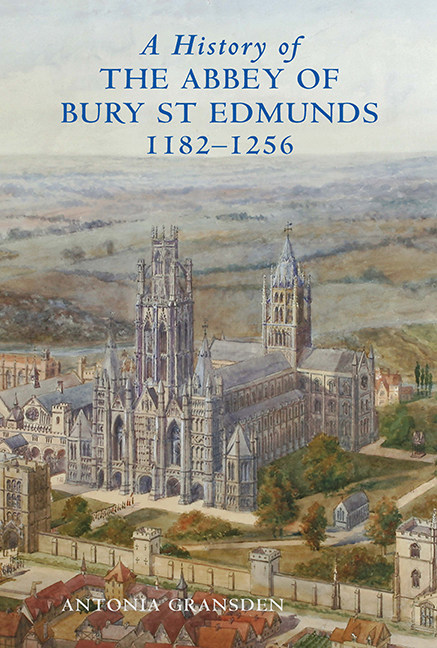PART II - The Abbey 1212–1256
Published online by Cambridge University Press: 29 April 2017
Summary
A vacancy of nearly three and a half years followed Samson's death on 30 December 1211, for reasons to be discussed below. In the period which followed until 1256 four abbots ruled in succession, Hugh of Northwold (that is Hugh II, 1213–29); Richard of the Isle (de Insula, de l'Isle, 1229–33); Henry of Rushbrooke (1233–48); and Edmund of Walpole (1248–56). The first three were able men – indeed Hugh of Northwold and Richard of the Isle were of outstanding ability, but with regard to Edmund of Walpole it is hard to form an opinion. Little is known about any of them and none has left a reputation at all equal to that of Samson or even to that of their two successors, Simon of Luton and John of Northwold. This may partly have been because their abbatiates were comparatively short, but it is mainly owing to the lack of sources.
There is nothing to show that any of the four abbots kept a cartulary or register, nor that any prior or obedientiary serving in their time kept one. Similarly, the literary sources are deficient. Jocelin of Brackland had no successor as the biographer of an abbot and a conventual chronicler, and the Electio Hugonis is the last piece of top-quality historical narrative produced at St Edmunds. Moreover, the tradition of writing a monastic chronicle dwindled in the abbey until it was revived under Simon of Luton in the late 1260s. Then the monk John Taxster composed a typical monastic chronicle covering the period from the Creation of the World to 1265 (later continued to 1301). But its annals are meagre until the mid-thirteenth century when they become progressively longer and more fluent. In any case, the chronicle is a general history, not a specifically house history and has few details about Abbots Hugh of Northwold (Hugh II), Richard of the Isle, Henry of Rushbrooke and Edmund of Walpole beyond recording the dates of their succession and deaths, nor is it much more informative about other aspects of the abbey's history. Fortunately, the Gesta Sacristarum is a valuable source for building achievements under these abbots and for other matters concerning the sacrist's office.
- Type
- Chapter
- Information
- A History of the Abbey of Bury St Edmunds, 1182–1256Samson of Tottington to Edmund of Walpole, pp. 149 - 150Publisher: Boydell & BrewerPrint publication year: 2007



